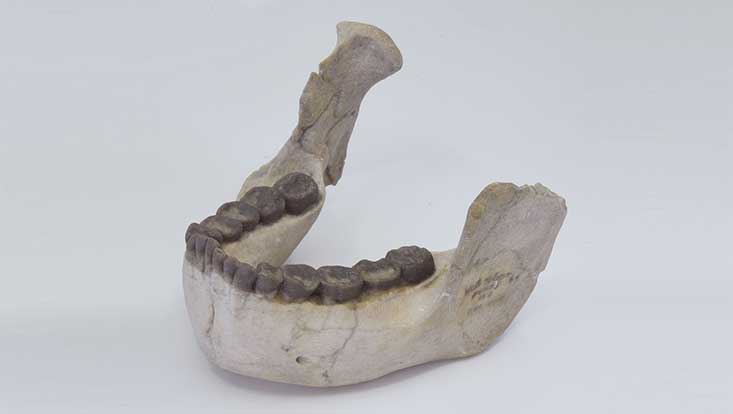
3D printing as a time machine - The "Peninj 1" mandible bone
2 July 2019

Photo: Christina Langenbach
Fossil bones and teeth are the only tangible documents of human evolution. They not only allow us to reconstruct the way of life of our ancestors, for example their diet, but can also make the influences of climate changes on cultural innovations and migration patterns comprehensible.
These fossils are irreplaceable and are therefore among the most scientifically significant and at the same time rarest research objects of all. Thomas M. Kaiser, head of the Department of Mammalogy/Paleoanthropology at LIB, researches the biomechanics of skeletons in collaboration with an international team of scientists. Here, function is reconstructed from form using large amounts of data. A very special prehuman mandible bone is our Treasure of the Month July - or rather, its replica.
The uniquely complete lower jaw of Peninj was discovered in 1964 by Kamoya Kimeu in deposits of the Pleistocene Lake Natron in northern Tanzania. It is about 1.5 million years old and shows typical features of the pre-human species Paranthropus boisei. These include the enormous molars and small incisors. These robust pre-humans became extinct about 1 million years ago.
Their age and rarity make originals like this so valuable that only a very small circle of people ever get to see them. Nevertheless, scientists want and need to be able to conduct research on them. 3D prints, which are made as copies of the original objects and thus enable visualization, play an outstanding role in this.
From digital data set to analog model
Such 3D prints are created in additive manufacturing processes from digital surface or volume models. In contrast to the conventional plastic impression process, the model is built up layer by layer in the 3D printer. This has the great advantage that it is also possible to reproduce the color effect of the surface, which would have to be dispensed with in the classic replica, which is actually an impression. The replica is then hardly distinguishable from the original. While 3D printing in plastics and metals is already widely used in technology, it is now also being widely applied in science. In the case of Peninj's lower jaw, the object was built from plaster powder. To reproduce the coloring, tiny droplets of paint are sprayed onto the plaster bed layer by layer from fine nozzles during the printing process, similar to a color print on paper. Only then is the next layer of plaster powder applied, solidified with water and again colored. At the end, the model is infiltrated with synthetic resin. This is the first color 3D print made of such a significant fossil. The virtual surface data for its realization was elaborately calculated using digital photos alone, produced as part of a bilateral research project between CeNak and the National Museum of Tanzania.
Not only useful as a research object
However, the goal of the project goes beyond the digitization of the unique World Heritage fossils for the biomechanical research questions: such high-quality replicas, which can hardly be distinguished from the original, are first-class exhibits for an exhibition. They are thus also a great innovation for knowledge transfer. Our 3D print of the Peninj mandible, which will be on display in the National Museum in Dar es Salaam (Tanzania) in the future, will also follow this path.
